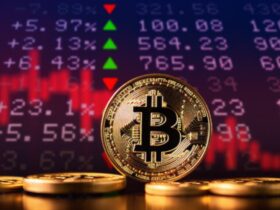Ethereum is establishing itself as one of the favorite networks for this industry.
RWA-specific tokens, such as ONDO, could still have upside potential.
The growth that real-world asset (RWA) tokenization is showing confirms that it is one of the most important trends of 2025 and that it is here to stay.
This has generated growing interest from investors, both individual and corporate, in cryptocurrencies backed by real assets such as real estate, stocks and bonds.
Furthermore, the tokenization of assets allows traditional financial markets to be brought closer to the decentralized finance (DeFi) ecosystem in an innovative way, generating new opportunities for integration between both worlds.
Proof of the growth of this trend is that RWA market capitalization is up more than 100% so far in 2025. Currently, it is 32.9 billion dollars, as seen in the following graph:


About 70% of the tokens in this sector represent private credits, and Most of the rest is Treasury bills and commodities.like oil or gold.
Precisely, World Liberty Financial, the DeFi platform linked to Donald Trump’s family, is studying the tokenization of oil.
Its CEO, Zack Witkoff, indicated at the TOKEN2049 conference that they are also considering including gas, cotton, wood and other products to be traded directly on cryptocurrency networks.
BlackRock, the largest asset manager in the world, is working along the same lines, which is also advancing in the tokenization of exchange-traded funds (ETFs) to strengthen its presence in the digital market.
The firm is studying digitizing funds linked to real assets, such as stocks, inspired by the success of the iShares Bitcoin Trust (IBIT), the largest spot bitcoin (BTC) ETF, currently holding 783,767 BTC valued at 98,469 million dollars.
This would allow trading without the time restrictions of Wall Street, facilitate access to global investors and enable new applications, transforming traditional assets such as stocks, bonds or commodities in digital tokens that speed up transactions, allow fractional buying and selling and reduce operating costs.
However, it must be clarified that BlackRock is not new to this market niche. The financial giant has BUIDL, a tokenized fund launched in March 2024 together with Securitize, which operates on Ethereum, Solana and Polygon.
Currently, BUIDL leads the tokenized Treasury bond market with a market capitalization of $2.8 billion.


In dialogue with CriptoNoticias, Erald Ghoos, CEO of OKX Europe, noted: “RWA is becoming a fundamental layer to connect traditional finance (TradFi) with DeFi. It allows a wide range of benefits, including 24/7 operating markets, programmable ownership and global accessibility.” Furthermore, he highlighted:
As regulatory clarity improves and infrastructure matures on-chainincluding compliant custody, identity and oracle solutions, RWAs can drive the next wave of institutional adoption and transform capital markets from the ground up.
Erald Ghoos, CEO of OKX Europe.
According to the projections of the BCG firm, the RWA industry could expand from 30 billion dollars to a range of between 4 and 16 billion in the coming yearsas reported by CriptoNoticias.
With growing institutional interest and the expansion of tokenized capital, several cryptocurrencies are emerging as potential winners of this trend. Below, we review five of them.
1-Ethereum
The network created by Vitalik Buterin is the one with the largest participation in the real-world asset tokenization industry. At the moment, RWAs that live on Ethereum exceed $10.32 billionas seen below:


Tokenization will drive new applications and operations on the Ethereum network, which concentrates much of these developments. Added to this is the preference of institutional investors for its solidity and decentralization. If that happens, the price of ether (ETH), the network’s native cryptocurrency, will be favored.
Grayscale, a digital asset management firm, highlighted in one of its reports that Ethereum is the best network for RWAs. “It is decentralized and credibly neutral for network participants, probably a requirement for any global platform for tokenized assets.”
The firm’s analysts explained that this ecosystem has the lead compared to other networks that operate in the RWA. Ethereum has more users, total value locked (TVL), and decentralized applications.
In this regard, Joseph Chalom, former director of BlackRock and current co-CEO of SharpLink Gaming, states: “As Ethereum becomes the settlement layer for trillions of assets, the long-term implication for the value of ETH is inevitable.”
2-Chainlink
Chainlink (LINK) is another cryptocurrency that could benefit from the rise of RWAs, as it acts as an essential bridge between real-world assets and cryptocurrency networks.
This is because its oracle network allows you to connect data and prices of traditional instruments – such as stocks, bonds or real estate – with decentralized applications, making the secure and verifiable tokenization of these assets possible.
Furthermore, its dominant position in the market (with more than 80% share among Ethereum oracles and a large presence in the DeFi ecosystem) consolidates it as the preferred infrastructure for institutional projects that seek interoperability and reliability in their tokenized operations.
That is to say, the more this industry grows, the greater the demand for reliable oracles. That’s where Chainlink is best positioned to capitalize on that expansion.
Analyst Miles Deutscher maintains that This expansion will take the price of the Chainlink cryptocurrency to levels never seen before. To argue his claim, he points out that Wall Street giants like BlackRock are promoting tokenization and highlights:
The fragmented, multi-chain world requires a universal translator, and Chainlink provides the solution.
Miles Deutscher, financial markets analyst.
3-Ondo
This is the native token of Ondo Finance, a platform that specializes in the creation and management of financial products backed by RWA assets.
Ondo’s main product is the Ondo Short-Term US Government Treasuries (OUSG), a token backed by BlackRock’s Institutional Digital Liquidity Fund (BUIDL) and short-term Treasury bonds.
At the moment, Ondo Finance has a market capitalization of $1,762 millionwhich consolidates it as the world’s third largest issuer of tokenized Treasury bonds.


John Murillo, Chief Business Officer at B2BROKER, spoke about the cryptocurrencies that could benefit the most from this expansion and highlighted: “Chainlink remains the foundation, as its oracle network connects real-world data to cryptocurrency networks, making institutional-grade tokenization possible. Ondo Finance is another key player, bridging the gap between US Treasuries and market funds. monetary with the efficiency of DeFi.”
4-Stellar
As explained in Criptopedia, educational section of CriptoNoticias, Stellar is a decentralized open source network created in 2014 by Jed McCaleb with the aim of facilitating fast and low-cost international transactions between different currencies or assets.
The platform has established itself as a bridge between the traditional financial system and the digital world, promoting more efficient global payments and remittances.
Its institutional adoption was reinforced when Franklin Templeton, one of the largest investment managers in the world, chose the Stellar network to issue its tokenized money market fundmarking a key step in the integration of RWA into its ecosystem.
Franklin Templeton, which manages more than $1.6 trillion, has its Benji platform, dedicated to the management of tokenized assets and distribution of returns.
Benji is integrated into Stellar, so if activity on the platform increases and institutional adoption grows, this could boost demand for the network and indirectly benefit the price of XLM, its native cryptocurrency.
5-Cardano
Cardano’s approach focuses on prioritizing quality over speed of developments. Its modular development promises to solve challenges such as scalability and sustainability, applying improvements gradually and safely to consolidate the network in the long term.
In line with that vision, the Cardano Foundation presented the six axes that will guide the next stage of its development, with the aim of strengthening its ecosystem, promoting community projects and promoting the growth of the DeFi sector within the network.
One of the highlights is the addition of RWA on Cardano. This advance could have a bullish impact for the project and for the native cryptocurrency, ADA, since it would attract institutional capital, increase activity within the network and could consolidate the ecosystem as a solid alternative for the issuance of tokenized assets.






Leave a Reply